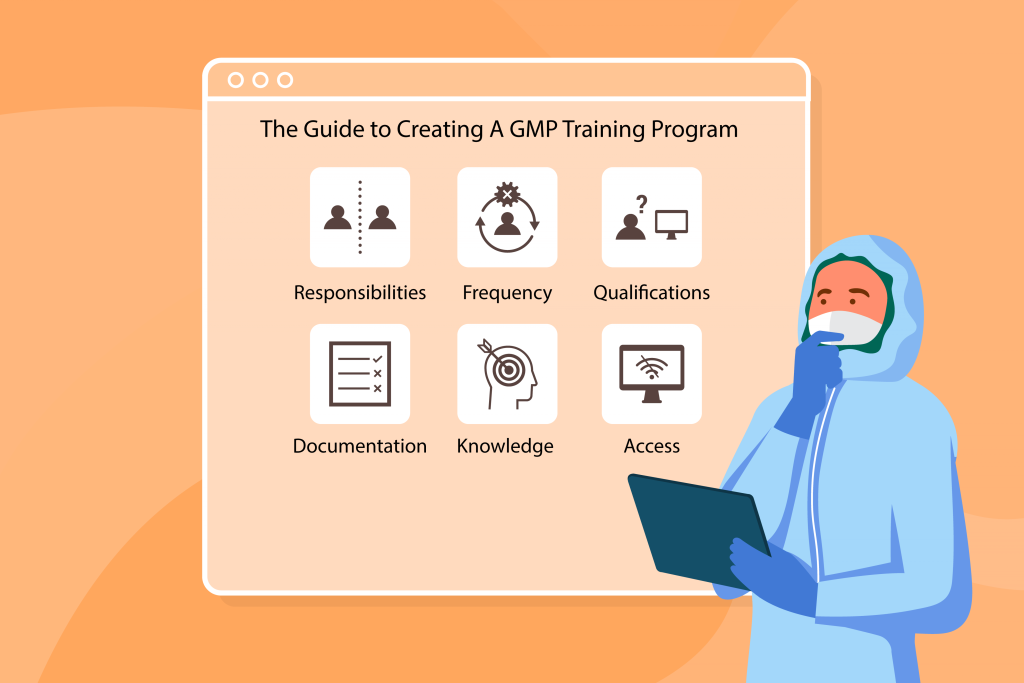Good Manufacturing Practices (GMPs – sometimes referred to as Current Good Manufacturing Practices or CGMPs) are federal regulations set by the FDA to cover how pharmaceuticals and food products are manufactured. They are guidelines taken for granted by many consumers – they assume what they put in their body will have been safely produced – but as manufacturers, it’s critical you maintain and monitor these standards. You must also be able to show how you are implementing them. An important part of this is regular GMP training for your employees.
 What Is GMP Training?
What Is GMP Training?
GMP training is an informational program that covers the required guidelines for your industry. Your GMP training will be required to cover specific best practices and guidelines for your manufacturing and packaging operations.
The following require personnel to attend GMP trainings:
- FDA 21CFR211.25(a)
- Joint IPEC-PQG Good Manufacturing Practices Guide for Pharmaceutical Excipients
- ICH Q7, Good Manufacturing Practice Guide for Active Pharmaceutical Ingredients, Section 3.12
Since these are required trainings, it’s important that you track your GMP training, as well as the GMP implementations in your production practices.
 Who Needs GMP Training?
Who Needs GMP Training?
The guideline 21CFR211.25 states, “Each person engaged in the manufacture, processing, packing, or holding of a drug product shall have education, training, and experience, or any combination thereof, to enable that person to perform the assigned functions.”
So, basically, your whole team should receive GMP training.
 How Often Should You Do GMP Training?
How Often Should You Do GMP Training?
GMP trainings should be conducted regularly to keep personnel up to date on any changes that happen in the guidelines.
21 CFR211.25 Personnel Qualifications and ICH Q7 Section 3.12 both dictate that training should be conducted often enough to keep personnel up to date. At the time of publishing, the FDA does not give a specific number of times each year that GMP training should be held.
There are recommendations, however, that GMP training should not be conducted in one large training each year, but, instead, should be held in small groups throughout the year. This will create a more beneficial and interactive experience to help personnel retain the information.
Best practice is to offer training whenever a new person starts on your team, returns after a long absence, or begins a new role. This ensures they have your high-standard GMP training and follow your guidelines.
You should also conduct training whenever new Standards of Practice (SOPs) are introduced – either into GMP guidelines or at the company level. Additionally, if you implement a computer system that is responsible for tracking GMPs (such as the tracking options found in our Apex Z) that changes cleanroom workflow, you should conduct training.
Lastly, if you find that human error is occurring, it is time to revisit your GMP training.
 What Do You Need To Make Note Of In Your GMP Training?
What Do You Need To Make Note Of In Your GMP Training?
Your training program needs to be thorough, but it also needs to be well-documented. Since it is required that you train, you need to show that you did and that you did it well. So, according to standards, you need to make note of:
- The scope of your training program.
- The definition of responsibilities.
- Your training frequency.
- Training plans for positions that require it.
- Your instructor’s qualifications.
- Documentation of training (including a sign-in sheet with every attendee’s name, signature, date, course number, session date, and instructor’s name/signature).
- Documentation of how effective the training is (this could include exams, attendee feedback, and statistical data).
- Approval of the sections of the training that is necessary for job responsibilities (this could include completeness, accuracy, relevancy, and meaningfulness of topics that are relevant to the company’s GMP training).
 What Should Your GMP Training Avoid?
What Should Your GMP Training Avoid?
Based on your industry, there is plenty of qualitative and quantitative information that you need to include. But what should you avoid?
Because this training can be so dense, avoid keeping it general.
If you conduct the training in small groups, you’ll be able to get really specific about what the people in those roles need to know. Since they will be able to identify with what you’re saying and apply it in real world settings, they will be more engaged and retain the information better.
To keep your personnel engaged, avoid letting just anyone train your employees.
The trainer should be highly qualified to conduct GMP training, but they should also be engaging. This is a lot of information to absorb and the more engaging a trainer is, the better.
Since the trainer should be able to answer questions and see personnel’s needs, avoid using video training.
A human is able to engage with people, answer questions, and see and understand their needs. This will help you to improve future trainings and get more out of each training session. Videos might be more cost-effective and easier to execute, but they lack the depth a good, live trainer brings to the role.
One of the benefits of having a trainer is getting feedback, so avoid letting time pass without re-evaluating training.
Your training needs to be re-evaluated often (as does your trainer). This will let you know that your employees are continuing to gain information and benefits from your training.
 Where Can You Learn More About GMP Training?
Where Can You Learn More About GMP Training?
So what should you actually include in your training? The GMPs of the pharmaceutical industry and related industries are fluctuating, so it is important to stay up to date on those changes in order to know what to include in your training.
We offer a free Knowledge Center that outlines current industry standards and best practices, so you can gather information to include in your GMP training all in one place.
You can register for your free account today and start building the content for your GMP training!


